Last night I had another Supper For The Promotion of Clericalism. Of course you get what I mean. There is a good clericalism, too, the sort whereby priests support each other in their identity, etc. There’s a lot of hooey out there today about “clericalism” being the root of all problems in the Church, including but not limited to, too much or too little use of incense, plants in the sanctuary, bad sound systems, and a lack of adequate parking. But I digress.
Last night’s clerical supper – served for six – presented as the main course the great Roman quinto quarto dish Coda alla vaccinara, oxtail stew. This is a typical Roman dish, especially of the area from Testaccio, through Ghetto, Trastevere and Regola, hence, exactly the area of Roma where I learned to speak in the streets and land on my feet, running. When I go back to Rome, I usually stay in the Regola zone, around Campo de’ Fiori where I know every paving stone by name. The denizens of that area, Regola, were sometimes called mangiacode, because they ate so much coda. There were, still are, lots of butchers around the place. Regola, by they way, comes from the older renula, referring to banks of the Tiber (before the embankments). This word is preserved in the Via Arenula which leads to the big bridge that crosses over into Trastevere.
I’ve never made coda alla vaccinara, but I’ve eaten it many times over the decades. With a lot of kitchen experience under my belt and some consultation, I plunged in. Mind you, I had seen the some great oxtails in the store, which got me thinking. Hence, I texted back and forth with The Great Roman™ for tips about how “granny” made it. This isn’t rocket science, but… but… you want to get it right, try to capture that Roman Thing.
I wrote about eating coda in Rome back in 2014. I remember that meal, which was at Osteria La Quercia, again in Regola, and close to Ss. Trinità dei Pelegrini. Mine was much better, I have to say. BTW… the ancient Confraternity that St. Philip Neri founded is being revived at Ss. Trinità! HERE
Card. Burke blessed some habits recently, in January, for investiture.
Dear reader, please understand that this is … how to put this… this is part of romanità. What follows is and isn’t a digression. IT is something of the feel, taste, ethos of every bite of coda alla vaccinara.
Churches, confraternities, the revival of the Roman Rite, the light in the streets in late afternoon, uneven pavement, and so many other elements of life there, form a whole, each seasoning and flavoring the others. And, mind you, since The Great Roman™ is involved also in the resuscitation of this Venerabile Arciconfraternita della Santissima Trinità dei pellegrini e convalescenti, which was founded by the co-patron of Rome to perform spiritual and corporal works of mercy, the new confratelli and consorelle are going to be involved in works of mercy as well.
This is not for dress up. This is for real.
Anyway, when I make Roman food, I strive to get something of … all of that into it.
Get your tails cut into pieces of 2-3 inches.
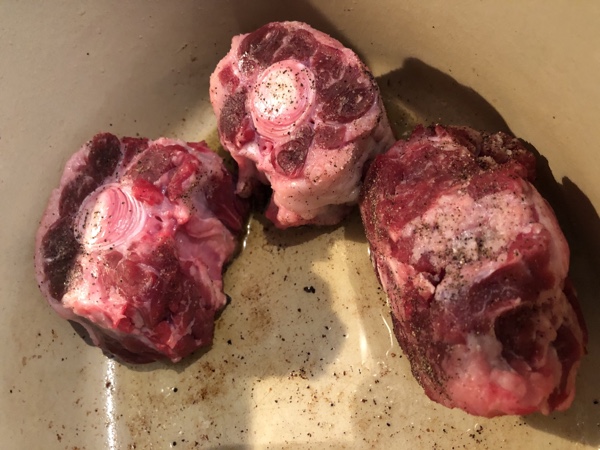
Season and put some color on them.
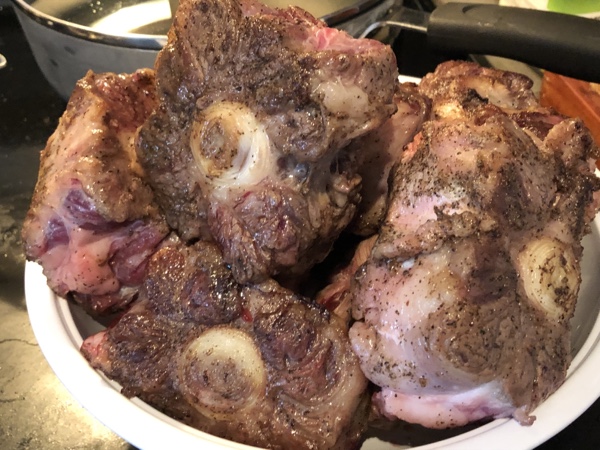
Pancetta…
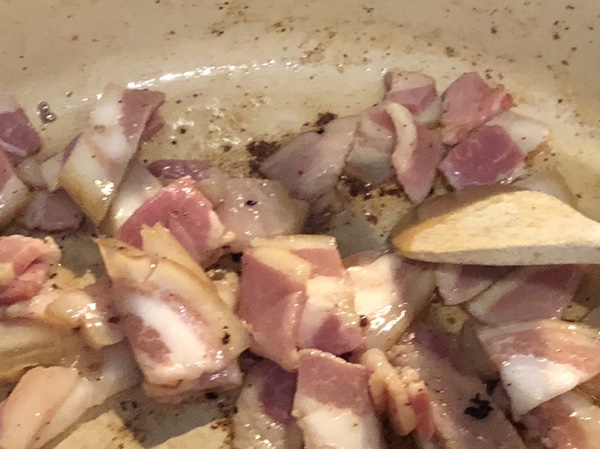
With your basics of carrot, onion and celery. There will be a LOT more celery down the line. That’s a key to good coda. Here we color up some veg and tomato paste.
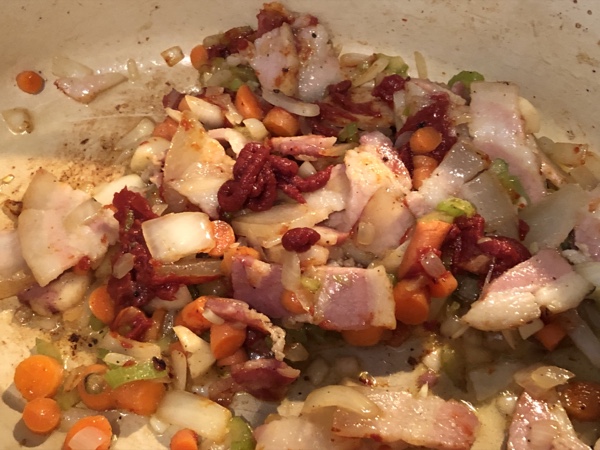
This was a point of discussion with The Great Roman™. Red wine or white? TGR convinced me that a dry white would be best, lest it too strongly influence the final flavor palette. So, dry white it was. About a half bottle went in, which deglazed and then reduced to a thick gravy.
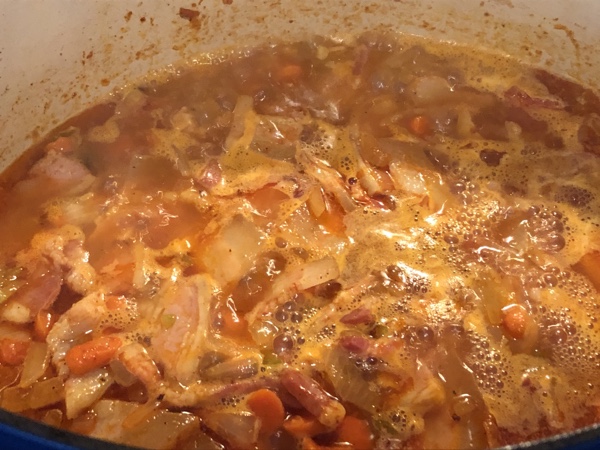
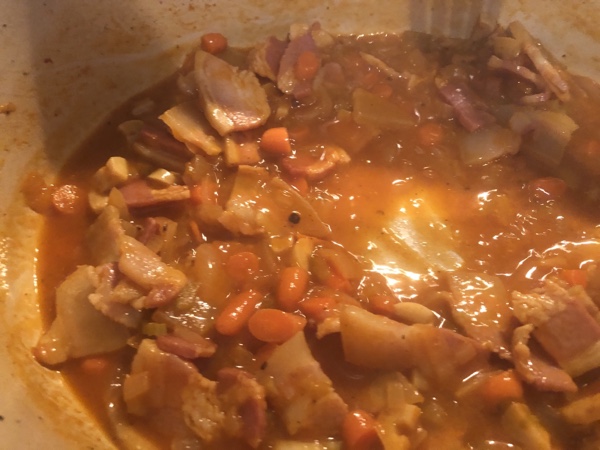
Then I added the tails, brick by brick, as it were. First, providing a layer of San Marzano (thank you to the reader who sent the tomatoes from my amazon wish list! I remembered you with a quick prayer and a sip of wine while cooking).
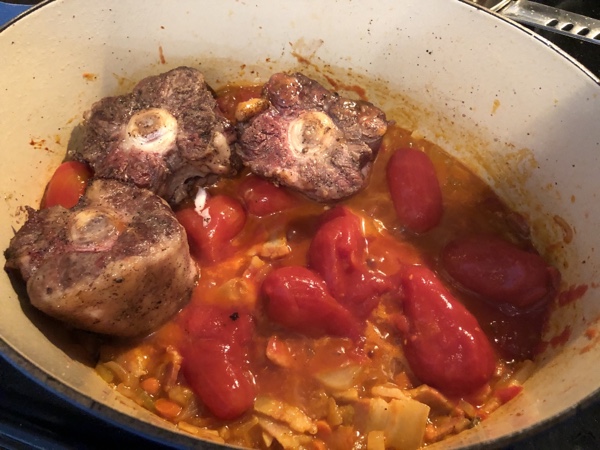
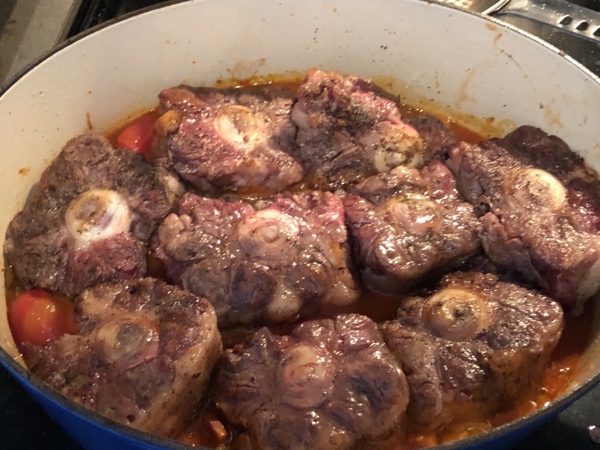
This dish needs bay leaves.
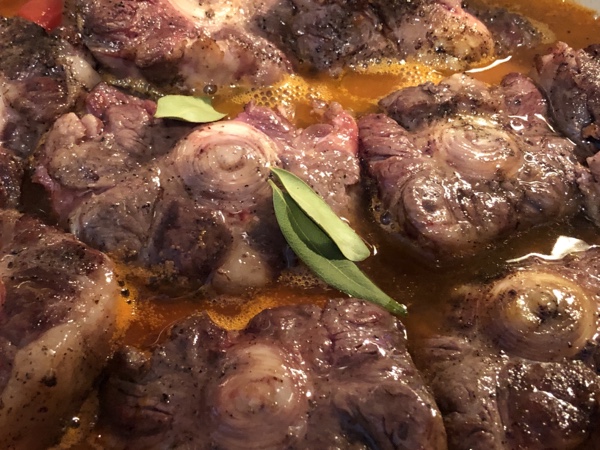
After that, I filled in the cracks with the juice from the tomatoes and more crushed tomato, with a bit more white wine. And, what you can’t see, the tricky part… a few nails of clove and a sprinkling of cinnamon.
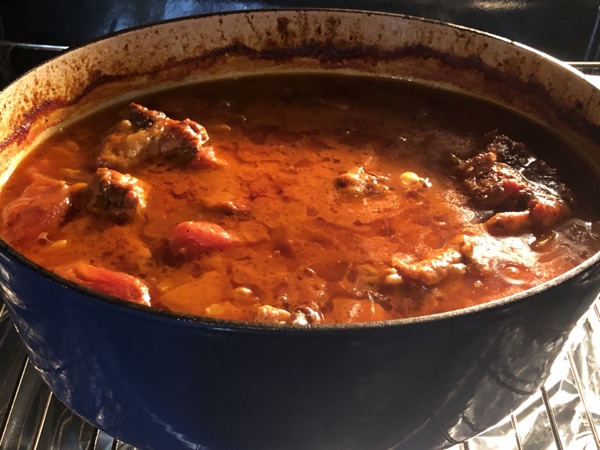
Then… it needed some hours to cook. I got it good and hot on the stove, then ovened it for a couple hours at 425F and then backed the heat off to 225F until it was time to go into the space where we were set up for dinner (my co (place is way to small).
There was no primo, such as a pasta. I debated caccio e pepe, but figured that the coda was going to be quite filling. Ergo, we had prosecco and various nuts and slices of calabrese and soppressata and, of course, peccorino. This was the weak link. It is really difficult to get the good stuff here.
Meanwhile, we had lots to talk about. This meme came in during our preprandial gab.

Time to add the rest of the celery. Coda is usually served with big chunks of celery. However, celery can be overwhelming. I waited till about an hour from serving to add large pieces… and carrots. I really like carrots.
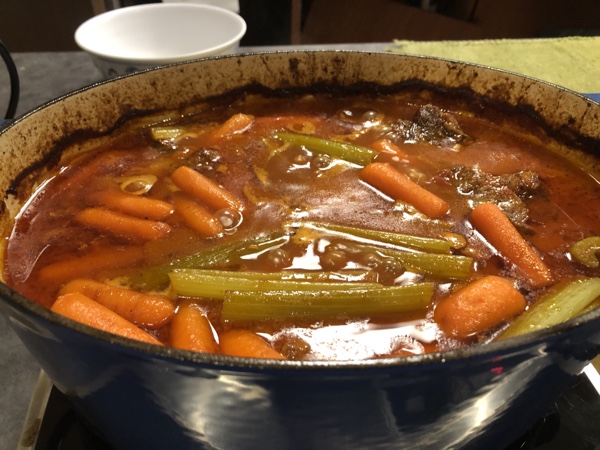
Patate al forno.
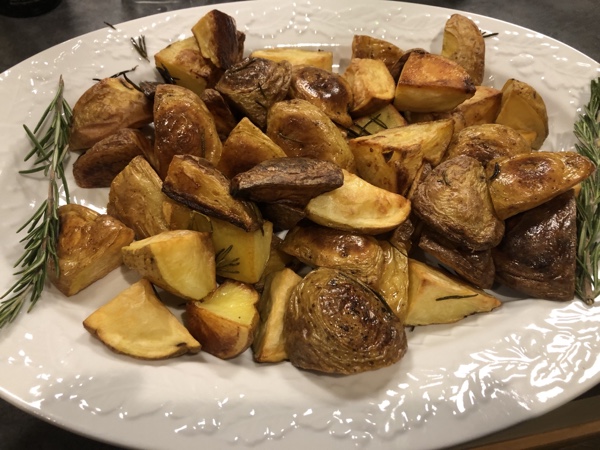
Here is the disappointing bit. I forget to take a photo of a prepared plate! I was busy. I had bread to bake, potatoes to extract, wine to pour – a good Barbera with acidity and sufficient tannin, great for a rustic dish. However, this photo from the interwebs looks very much like my final production, sans potatoes.
The meat literally fell from the blades of the tail bones. The whole place was roused with the robust fragrance of the celery and, underneath it, the clove and cinnamon. Sometimes coda is sprinkled with pine nuts, but, after all the nuts during our pre-prandials, I left them aside.
This was followed by a mixed green salad with a garlic and tomato vinaigrette dressing.
My desserts are simple: mini Dove bars and, this time, wonderfully tart clementines, supplemented with amaro Braulio.
I have some sauce left over and pieces of the tail, which I’ve put away in the freezer: they’ll garnish some rigatoni someday soon.
I very much enjoy making these suppers for the brethren. They are also a way of my showing appreciation for their participation in – and promotion of – celebrations of the Traditional Latin Mass. They work with my Society and we do good things together.

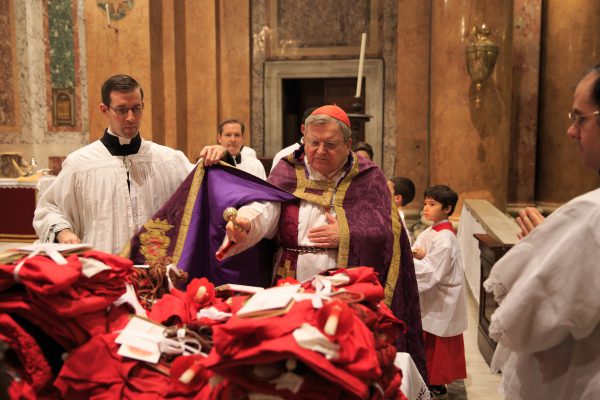

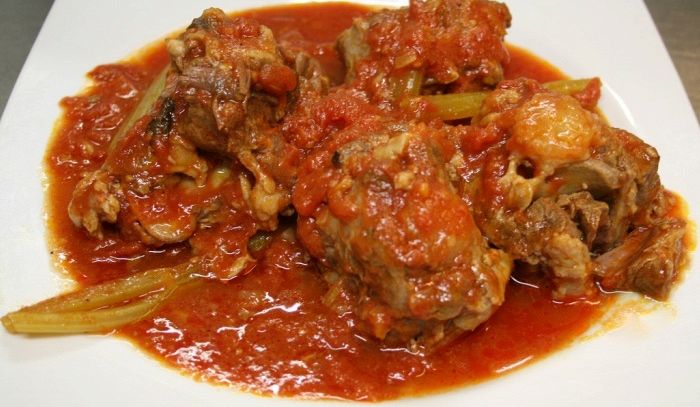

































That is flippin’ AWESOME!!!
You’re a good man Fr Z! Anybody who takes Roman cooking this seriously deserves great respect. And yes, though I don’t know how exactly, seeing Cardinal Burke blessing red vestments, experiencing reverent liturgies and an extensive discussion on coda alla vaccinara, it…it just makes sense; I get it. I can’t explain it, but yes, it’s just metaphysically correct.
Does pancetta go by another name? I can’t find it, but I do often find something that looks similar, salted pork, in small vac pack packaging that looks like mini bacon.
Well, my mouth is watering.
Just out of curiosity–what sort of olive oil do you use? I’m on a quest to find the best one!
[For the hot work in the pan it is not necessary to get a super high quality oil. As soon as the heat hits it, that wonderful fragrance goes aerosol, into the air anyway. Get a decent bottle of extra-virgin and don’t fret too much. However, for cold work, as making salad dressings or drizzling on food, that’s another matter. I get a domestic oil from California made by Olive Press. They have several styles. I am partial to their olio nuovo, which is, as you might guess, seasonal.]
Thank you for posting your recipe and the photos. You gladdened my heart today, especially with the news about the confraternity being revived at Sta. Trinita. Keep posting your recipes and your good news. We need them.
You can use thick cut bacon. Don’t get the flavored bacon. I’ve used salt pork. Just remember that you have to adjust, constantly.
The idea is: know what you want to produce.
Improvise. Adapt. Overcome.
That just looks divine.
That’s something my mother, of German heritage used to make.
Seems to me there were extra oxtails on the side, meat falling off the bones,
we would hold them like tiny corn on the cob and … just delicious.
Yes, lots of celery and the leaves, carrots, onions, tomatoes.
How timely! I just saw some oxtails in the store, remembered my mother’s fixing them, but couldn’t recall the details. I did get a beef kidney, which is mild-flavored the way I used to fix it way back–even liked by kids. I hadn’t seen either in the meat area of the local Meijer store (a Michigan-Indiana chain) before. They were both labeled “Specialty Beef”, and were inexpensive by today’s standards. Seems to me such less common cuts used to be called “Variety Meats”, along with beef heart, brains, and tripe. They were really cheap. Nobody bothered with them except the poor, and we mothers of large families. Then, I guess, even “the poor” lost the knack of cooking them, so stores stopped carrying them. I have to confess, that I never cottoned to brains or tripe; the former takes too much disguising, and the latter wasn’t nutritionally dense enough to be worth fussing over.